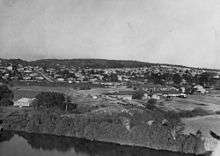Animal Research Institute, Yeerongpilly
The Animal Research Institute, Yeerongpilly (ARI) was a government science complex at Yeerongpilly, Queensland, Australia, serving the agricultural sector of Queensland. A number of the Animal Research Institute Buildings are heritage-listed, added to the Queensland Heritage Register in 2008.[1]
| Animal Research Institute, Yeerongpilly | |
|---|---|
 Animal research complex at Yeerongpilly, 1946 | |
| Location | Yeerongpilly, Queensland, Australia |
| Coordinates | 27°31′29″S 153°00′41″E |
| Founded | Stock Experiment Station 1909 |
| Place Category | Education, Research, Scientific Facility |
| Place Type | Research station |
| Vacated | 2011 |
 Site location | |
History
The site was proposed and established by Sydney Dodd in 1909 as the Stock Experiment Station for the then Queensland Department of Agriculture and Stock. The land had been occupied in the 19th century by the King family, Parr Smith – headmaster of the Yeronga State School, and A. A. McDiarmid.[2] With Dodd began the site's long-standing contribution to the cattle industry in the protection against tick fever (babesiosis, anaplasmosis).[3] In 1910 the Government Bacteriologist Charles Joseph Pound, inaugural director of the Queensland Stock Institute, took charge of the station for the next 22 years.[4]
From 1932 to 1953 the complex was known as the Animal Health Station. In this period the site's various scientific disciplines became specialised roles, and the Department's biochemical and toxicological laboratory sections were also transferred there.[5] The CSIRO, known then as the Council for Scientific and Industrial Research (CSIR), and the University of Queensland's Veterinary School first occupied parts of the site during this era.[6] In World War II the United States Army utilised the Veterinary School building, with a laboratory and malaria school formed as part of the 3rd Medical Laboratory in 1942.[7]

In 1953, the complex became the Animal Research Institute. Immunologist and Nobel Laureate Peter C. Doherty worked at Yeerongpilly in the 1960s, involved in diagnostic veterinary pathology and a project on the epidemiology of bovine leptospirosis.[8] A national campaign to eradicate bovine brucellosis and tuberculosis (BTEC) was supported by a set of laboratories built on the site in the 1970s.[9] The investigation of Hendra virus, first described after an outbreak at a Brisbane suburb in 1994, included researchers at Yeerongpilly.[10]
In 2009, the site celebrated a centenary of contribution to veterinary pathology, microbiology, biometry, biochemistry, animal husbandry, information and extension.[10] The Institute had vacated the site in 2011,[6] relocating activities to other facilities.
Redevelopment

In January 2014 a draft plan for redevelopment of the 14-hectare site of the former Institute was released by the Queensland Government. It proposed the Yeerongpilly transit-oriented development to establish urban communities around transit stations.[11]
See also
- Department of Agriculture, Fisheries and Forestry, Queensland
- Centre for Advanced Animal Science (CAAS), University of Queensland Gatton Campus
- Ecosciences Precinct, Dutton Park
- Health and Food Sciences Precinct, Coopers Plains
References
- "Animal Research Institute (former) (entry 602598)". Queensland Heritage Register. Queensland Heritage Council. Retrieved 19 June 2013.
- "Do You Know Your Brisbane? Yeerongpilly". Sunday Mail (Brisbane) (Qld. : 1926 - 1954). Brisbane. 12 May 1929. p. 27. Retrieved 31 May 2014.
- "The Queensland Pastoralist - Government Stock Institute". The Queenslander (Brisbane, Qld. : 1866 - 1939). Brisbane. 16 October 1909. p. 38. Retrieved 8 June 2012.
- Angus, Beverley M. "Pound, Charles Joseph (1866–1946)". Australian Dictionary of Biography. National Centre of Biography, Australian National University. Retrieved 31 May 2012.
- Laws, Lionel (1997). "Queensland Government Veterinary Laboratory Services" (PDF). In P. J. Mylrea (ed.). Australian Veterinary History Record. Australian Veterinary History Society AGM 1997. November 2000 no. 29. Brisbane. pp. 14–26. Retrieved 31 May 2012.
- "Animal Research Institute (former) (entry 602598)". Queensland Heritage Register. Queensland Heritage Council. Retrieved 31 May 2012.
- "3d Medical Laboratory". WW2 US Medical Research Centre. Archived from the original on 17 April 2012. Retrieved 31 May 2012.
- "Peter C. Doherty - Autobiography". The Nobel Prize in Physiology or Medicine 1996. The Nobel Foundation. Retrieved 31 May 2012.
- Lehane, Robert & CSIRO (1996). Beating the odds in a big country. : The eradication of bovine brucellosis and tuberculosis in Australia. Collingwood: CSIRO Publishing. ISBN 978-0-643-05814-9.
- "Queensland's Animal Research Institute - 100 years of agricultural breakthroughs". Ministerial Media Statement. Brisbane: Department of the Premier and Cabinet, Queensland Government. Retrieved 31 May 2012.
- "Yeerongpilly Transit Oriented Development". Land Use Planning. Department of State Development, Infrastructure and Planning, Queensland Government. Archived from the original on 25 February 2014. Retrieved 31 May 2014.
Further reading
- Resources for Animal Research Institute (Qld.). Trove - National Library of Australia
- "At Yeerongpilly Stock Institute". The Queenslander (Brisbane, Qld. : 1866 - 1939). Brisbane, Qld.: National Library of Australia. 25 February 1911. p. 25. Retrieved 28 June 2012.
- Aerial view of the Animal Health Station in 1933. Pandora - National Library of Australia
- Animal Research Institute (Qld.). Pathology Branch (1976), Brucellosis and tuberculosis laboratory, Pathology Branch, Animal Research Institute, ISBN 978-0-7242-0344-4
- Animal Research Institute (Qld.); Kerr, Ruth; Queensland. Department of Employment, Economic development and Innovation (2009), The Animal Research Institute : celebrating 100 years, Department of Employment, Economic development and Innovation, Queensland
- Elder, J. K. (1988), QDPI Veterinary Laboratories - Microbiology Highlights 1893 to 1988, Brisbane: Department of Primary Industries, Queensland Government
- Elder, J. K. (1990), Queensland Government animal health services, 1859-1990 : with particular reference to the veterinary laboratories, Brisbane: Department of Primary Industries, Queensland Government
- eResearch Archive Department of Employment, Economic Development and Innovation, Queensland.
- Web Archive - Queensland Department of Primary Industries (2003, 2004) Pandora - National Library of Australia
External links
| Wikimedia Commons has media related to Animal Research Institute, Yeerongpilly. |